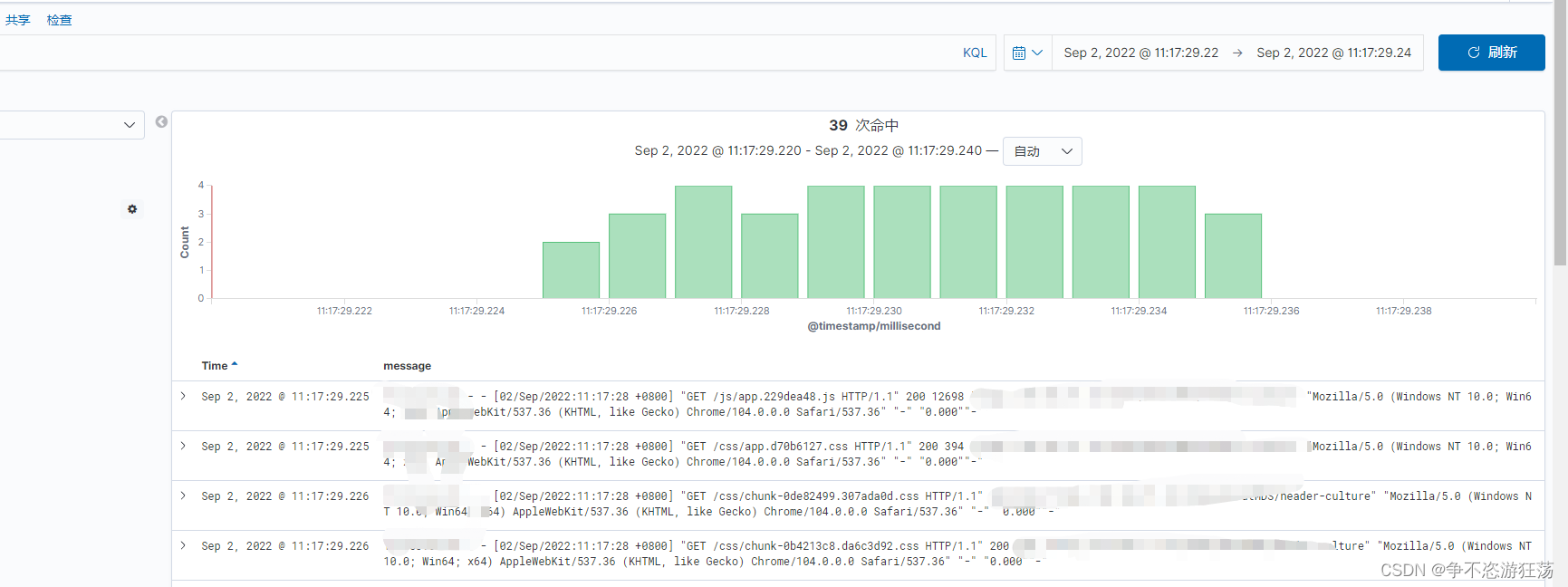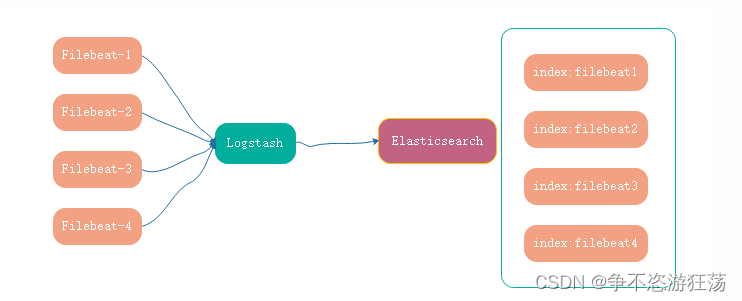ELK-B架构介绍
ELK分别表示Elasticsearch、Logstash、Kibana,是一套完整的日志收集以及展示的解决方案。新增了一个FileBeat,是一个轻量型的日志收集处理工具,FileBeat占用的资源少,适合在各个服务器上搜集日志后传输给Logstash;
Elasticsearch简称ES,是一个基于Lucene的、支持全文索引的分布式存储和索引引擎,提供搜集、分析、存储数据三大功能,特点是具备分布式、零配置、自动发现、索引自动分片、索引副本机制、restFul风格接口、多数据源、自动搜索负载等。主要负责将日志索引存储起来,方便业务搜索查询;
Logstash是一个具有实时传输能力的数据收集引擎,是日志收集、过滤、转发的中间件,支持大量的数据获取方式,一般工作方式为C/S架构,client端安装在需要收集日志的主机上,Server端负责将收到的各节点日志进行过滤、修改等操作在一并发往elasticsearch上去,主要负责将各条业务线的各类日志统一收集、过滤后、转发给ES进行下一步的处理;
Kibana提供给了ES和Logstash一个友好的可视化Web界面,可以帮助汇总、分析和搜索重要数据汇总,可以在ES的索引中查找,交互数据,并且生成各种纬度表格;
FileBeat,是一个轻量级的开源日志文件数据搜集器,基于Logstash-Forwarder源代码开发,在需要采集的Server上安装FileBeat,并且指定日志目录或者日志文件后,FileBeat就能读取数据,迅速发送到Logstash进行解析,也可以直接发送到ES中进行集中式的存储和分析;

一.Elasticsearch安装
(1).操作系统调优(必须配置,否则ES起不来)
【1】内存优化
在/etc/sysctl.conf添加如下内容
fs.file-max=655360
vm.max_map_count=655360
刷新生效
sysctl -p
解释:
(1)vm.max_map_count=655360
系统最大打开文件描述符数
(2)vm.max_map_count=655360
限制一个进程拥有虚拟内存区域的大小
【2】修改
vim /etc/security/limits.conf
-
* soft nofile 65536 * hard nofile 65536 * soft nproc 65536 * hard nproc 65536 * soft memlock unlimited * hard memlock unlimited
解释:
(nofile)最大开打开文件描述符
(nproc)最大用户进程数
(memlock)最大锁定内存地址空间
(2)新建文件夹并上传elasticsearch文件
mkdir /opt/elasticsearch
tar -zxvf elasticsearch-7.4.2-linux-x86_64.tar.gz
(3)修改es配置文件
vim ./config/elasticsearch.yml
cluster.name: my-application # 集群名称
node.name: node-1 # 节点名称,仅仅是描述名称,用于在日志中区分
# Path to directory where to store the data (separate multiple locations by comma):
#
path.data: /opt/elasticsearch/data # 数据的默认存放路径
#
# Path to log files:
#
path.logs: /opt/elasticsearch/logs # 日志的默认存放路径
#
# Set the bind address to a specific IP (IPv4 or IPv6):
#
network.host: 0.0.0.0
#
# Set a custom port for HTTP:
#
http.port: 9200
#
# Pass an initial list of hosts to perform discovery when this node is started:
# The default list of hosts is ["127.0.0.1", "[::1]"]
#
discovery.seed_hosts: ["172.31.0.24"] #集群个节点IP地址
#
# Bootstrap the cluster using an initial set of master-eligible nodes:
#
cluster.initial_master_nodes: ["node-1"] #master节点资格
#
# For more information, consult the discovery and cluster formation module documentation.
(4)添加elasticsearch启动用户
adduser es //创建一个账号为 es的用户
chown -R es:es /opt/elasticsearch/ //给es用户赋予操作此文件夹的权限
su es // 使用 es账户操作,如果是 su root 意为使用 root用户操作
(5)安装ik分词器
在/opt/elasticsearch/elasticsearch/plugins下新建ik文件夹
mkdir /opt/elasticsearch/elasticsearch/plugins/ik
将elasticsearch-analysis-ik-7.4.2.zip上传到ik文件夹下并解压
yum install -y unzip //下载unzip命令
unzip elasticsearch-analysis-ik-7.4.2.zip //解压文件夹
bin目录下查看已经加载的插件
./elasticsearch-plugin list
(6)启动es
在elasticsearch的bin目录下
//需要用es用户启动
./elasticsearch //前台启动
./elasticsearch -d //后台启动
http://127.0.0.1:9200/_cat/nodes?v&s=index //查看节点信息
http://127.0.0.1:9200/_cat/indices?v //查看索引信息
二.kibana安装
(1)上传安装包 解压并改名
tar -zxvf kibana-7.4.2-linux-x86_64.tar.gz
mv ./kibana-7.4.2 /kibana
chown -R es:es /opt/kibana
(2)配置config/kibana.yml
server.port: 5601 //端口
# Specifies the address to which the Kibana server will bind. IP addresses and host names are both valid values.
# The default is 'localhost', which usually means remote machines will not be able to connect.
# To allow connections from remote users, set this parameter to a non-loopback address.
server.host: "0.0.0.0" //允许来自远程用户的连接
server.name: "my_kibana" //服务名称
# The URLs of the Elasticsearch instances to use for all your queries.
elasticsearch.hosts: ["http://172.31.0.24:9200"] //elasticsearch地址
# Specifies locale to be used for all localizable strings, dates and number formats.
# Supported languages are the following: English - en , by default , Chinese - zh-CN .
i18n.locale: "zh-CN" //中文
(3)启动kibana
su es //使用es用户启动
bin/kibana //前台启动
nohup bin/kibana & //后台启动
三.安装logstash
(1)上传安装包 解压并改名
tar -zxvf /opt/elasticsearch/logstash-7.4.2.tar.gz
cd /opt/elasticsearch/logstash-7.4.2
(2)新建config/收集nginx接口日志
vim nginxtest.conf
input{
file{
path => "/var/log/nginx/access.log" # 想要收集的日志信息文件-注意全路径
type=>"logstash_log" # 指定一个类型
start_position =>"beginning" # 说明从文件最开始读
}
}
#@timestamp比当前时间慢8小时
filter {
ruby {
code => "event.set('timestamp', event.get('@timestamp').time.localtime + 8*60*60)"
}
ruby {
code => "event.set('@timestamp',event.get('timestamp'))"
}
mutate {
remove_field => ["timestamp"]
}
}
##@timestamp比当前时间快8小时
#修改kibana当前时区 GMT+0 (默认获取浏览器时间)
output{
elasticsearch{ # 配置elasticsearch接收数据信息
hosts=>["http://127.0.0.1:9200"] # 配置elasticsearch端口信息
index=>"log-%{+YYYY.MM.dd}" # 配置Kibana新建index,比如我这里是”log-“开头,在Kibana可以写”log-*”
#使用自定义索引模板
template => "/opt/elasticsearch/logstash-7.4.2/nginxtest.json"
template_name => "log-*"
template_overwrite => true
}
}
(3)新建json文件/nginxtest.json
Elasticsearch-7x版本的基本模板
https://github.com/logstash-plugins/logstash-output-elasticsearch/blob/main/lib/logstash/outputs/elasticsearch/templates/ecs-disabled/elasticsearch-7x.json
Es为单节点生成日志索引副本数默认是1,新建的索引会有未分配碎片
vim nginxtest.json
{
"index_patterns" : "log-*",
"version" : 60001,
"settings" : {
"index.refresh_interval" : "5s",
"index.number_of_replicas" : 0, //副本数改为0
"number_of_shards": 1
},
"mappings" : {
"dynamic_templates" : [ {
"message_field" : {
"path_match" : "message",
"match_mapping_type" : "string",
"mapping" : {
"type" : "text",
"norms" : false
}
}
}, {
"string_fields" : {
"match" : "*",
"match_mapping_type" : "string",
"mapping" : {
"type" : "text", "norms" : false,
"fields" : {
"keyword" : { "type": "keyword", "ignore_above": 256 }
}
}
}
} ],
"properties" : {
"@timestamp": { "type": "date"},
"@version": { "type": "keyword"},
"geoip" : {
"dynamic": true,
"properties" : {
"ip": { "type": "ip" },
"location" : { "type" : "geo_point" },
"latitude" : { "type" : "half_float" },
"longitude" : { "type" : "half_float" }
}
}
}
}
}
(4)启动logstash
./bin/logstash -f nginxtest.conf -t //检查配置文件是否正确
./bin/logstash -f nginxtest.conf //启动logstash
四、查看索引信息


五、安装filebeat
服务器上常常跑着不同的服务且不止一台服务器的情况下,收集这些log时候,通常会需要定义成不同的索引。因此需要对收集的日志进行区分。

(1)下载安装包
filebeat-7.4.2-linux-x86_64.tar.gz
(2)修改配置文件
#=========================== Filebeat inputs =============================
filebeat.inputs:
# Each - is an input. Most options can be set at the input level, so
# you can use different inputs for various configurations.
# Below are the input specific configurations.
- type: log
# Change to true to enable this input configuration.
enabled: true
# Paths that should be crawled and fetched. Glob based paths.
paths:
- /var/log/*.log
#- c:\programdata\elasticsearch\logs\*
fields: ##可选字段,选择额外的字段进行输出可以是标量值,元组,字典等嵌套类型
# level: debug
# review: 1
filetype: sys #自定义类型用于logstash区分
#============================= Filebeat modules ===============================
filebeat.config.modules:
# Glob pattern for configuration loading
path: ${path.config}/modules.d/*.yml
# Set to true to enable config reloading
reload.enabled: false
# Period on which files under path should be checked for changes
#reload.period: 10s
#==================== Elasticsearch template setting ==========================
setup.template.settings:
index.number_of_shards: 1
#index.codec: best_compression
#_source.enabled: false
#----------------------------- Logstash output --------------------------------
output.logstash:
# The Logstash hosts
hosts: ["localhost:5044"]
# Optional SSL. By default is off.
# List of root certificates for HTTPS server verifications
#ssl.certificate_authorities: ["/etc/pki/root/ca.pem"]
# Certificate for SSL client authentication
#ssl.certificate: "/etc/pki/client/cert.pem"
# Client Certificate Key
#ssl.key: "/etc/pki/client/cert.key"
#=========================== 调优 =============================
## 调优 避免 占用内存过大
## 是否因为通配符的原因,造成同时监控数量巨大的文件
## 是否文件的单行内容巨大,日志记录不规范
## 是否output经常阻塞,event queue里面总是一直缓存event
max_procs: 1
queue.mem.events: 256
queue.mem.flush.min_events: 128
(3)启动filebeat
#查看启用或禁用模块:
./filebeat modules list
#启用logstash模块
./filebeat modules enable logstash
#检查配置文件是否正确
./filebeat test config
#启动filebeat
nohup ./filebeat -e -c filebeat-log.yml >/dev/null 2>&1 &
(4)将filebeat加入到服务
1.通过nohup方式启动filebeat,运行一段时间后filebeat自动退出。
原因是filebeat默认会定期检测文件是否有新的内容,如果超过一定时间检测的文件没有任务新日志写入,那么filebeat会自动退出,解决办法就是将filebeat通过系统后台的方式长期运行。
vim /etc/systemd/system/filebeat.service
[Unit]
Description=Filebeat is a lightweight shipper for metrics.
Documentation=https://www.elastic.co/products/beats/filebeat
Wants=network-online.target
After=network-online.target
[Service]
Environment="LOG_OPTS=-e"
Environment="CONFIG_OPTS=-c /opt/elasticsearch/filebeat-7.4.2-linux-x86_64/filebeat.yml"
Environment="PATH_OPTS=-path.home /opt/elasticsearch/filebeat-7.4.2-linux-x86_64/filebeat -path.config /opt/elasticsearch/filebeat-7.4.2-linux-x86_64 -path.data /opt/elasticsearch/filebeat-7.4.2-linux-x86_64/data -path.logs /opt/elasticsearch/filebeat-7.4.2-linux-x86_64/logs"
ExecStart=/opt/elasticsearch/filebeat-7.4.2-linux-x86_64/filebeat $LOG_OPTS $CONFIG_OPTS $PATH_OPTS
Restart=always
[Install]
WantedBy=multi-user.target
2.给该文件给予可执行的权限:
chmod +x /etc/systemd/system/filebeat.service
3.系统后台服务方式启动:
# 依次执行下列命令
systemctl daemon-reload
systemctl enable filebeat
systemctl start filebeat
(5)多filebeat配置方式
input{
beats{
port => 5044
# type => "beats"
}
file{
path => "/var/log/nginx/access.log" # 想要收集的日志信息文件-注意全路径
type=>"nginxlog" # 指定一个类型
start_position =>"beginning" # 说明从文件最开始读
}
}
filter {
ruby {
code => "event.set('timestamp', event.get('@timestamp').time.localtime + 8*60*60)"
}
ruby {
code => "event.set('@timestamp',event.get('timestamp'))"
}
mutate {
remove_field => ["timestamp"]
}
# if[type] == "beats" {
# mutate {
# add_tag => ["beats"]
# }
# }
if [type] == "nginxlog" {
mutate {
add_tag => ["nginxlog"]
}
grok {
match => { "message" => "%{COMBINEDAPACHELOG}" }
}
}
}
output{
if [fields][filetype] == "sys" {
elasticsearch{ # 配置elasticsearch接收数据信息
hosts=>["http://127.0.0.1:9200"] # 配置elasticsearch端口信息
index=>"elkblog-%{+YYYY.MM.dd}" # 配置Kibana新建index,比如我这里是”log-“开头,在Kibana可以写”log-*”
#使用自定义索引模板
template => "/opt/elasticsearch/logstash-7.4.2/elkb.json"
template_name => "elkblog-*"
template_overwrite => true
}
}
if "nginxlog" in [tags] {
elasticsearch{ # 配置elasticsearch接收数据信息
hosts=>["http://127.0.0.1:9200"] # 配置elasticsearch端口信息
index=>"log-%{+YYYY.MM.dd}" # 配置Kibana新建index,比如我这里是”log-“开头,在Kibana可以写”log-*”
#使用自定义索引模板
template => "/opt/elasticsearch/logstash-7.4.2/nginxtest.json"
template_name => "log-*"
template_overwrite => true
}
}
if [fields][filetype] == "blys" {
elasticsearch{ # 配置elasticsearch接收数据信息
hosts=>["http://127.0.0.1:9200"] # 配置elasticsearch端口信息
index=>"blyslog-%{+YYYY.MM.dd}" # 配置Kibana新建index,比如我这里是”log-“开头,在Kibana可以写”log-*”
#使用自定义索引模板
template => "/opt/elasticsearch/logstash-7.4.2/elkb.json"
template_name => "elkblog-*"
template_overwrite => true
}
}
}
六、定时清理日志索引
(1)编写清理es索引脚本
#!/bin/bash
time=$(date -d '-30days' +'%Y.%m.%d')
curl -XDELETE http://localhost:9200/*log-${time}
//保留日志索引一个月
(2)加入定时任务
crontab -e
20 01 * * * . /etc/profile;/bin/sh /opt/elasticsearch/deleteesindex.sh > /dev/null 2>&1






















 450
450











 被折叠的 条评论
为什么被折叠?
被折叠的 条评论
为什么被折叠?








